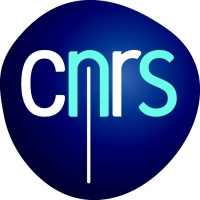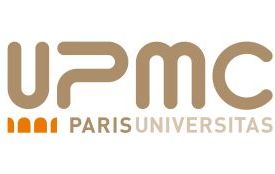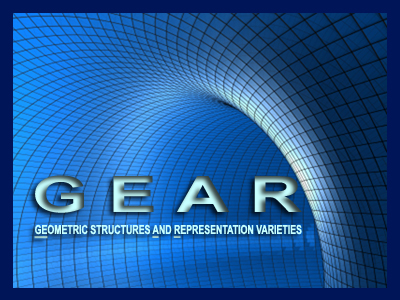Speaker: Francis Bonahon (University of Southern California)
Title: The drill-baby-drill strategy
Abstract: To construct homomorphisms from a surface group to SL_2(C), both in the classical and quantum framework, punctured surfaces are easier to deal with than closed surfaces. I will discuss a strategy to deal with closed surfaces, where you drill punctures and balance the added complexity by restricting to appropriate subspaces. In general, the more punctures the better for proofs and independence of choices.
Speaker: Michelle Bucher (Université de Genève)
Title: Bounded cohomology, volumes and rigidity II
Abstract: Let M be a 3-manifold. A finite volume hyperbolization of M corresponds to a lattice injection of the fundamental group into SL(2,C) and we can think of the volume of the manifold as an invariant of this injection. We extend this invariant to arbitrary representations of the fundamental group into SL(n,C) and we characterize the representations that correspond to its maximal value. Our definition of the invariant depends of the study of the bounded cohomology of SL(n,C) in degree three (as discussed in the second talk), but we will illustrate instead in the first talk a characterization in terms of ideal triangulations of the manifolds, following ideas of various authors for a restricted family of representations Bergeron–Guilloux–Falbel, Garoufalidis–D. Thurston–Zickert). In order to do so, we give an explicit and palatable definition of the extension of Goncharov’s cocycle to all configurations of flags. In the second talk we will show which properties of a cocycle representing the non trivial class in degree 3 in the cohomology of SL(n,C) are crucial to prove that the geometric representation is the unique maximum value of this volume. This is joint work of Michelle Bucher and Alessandra Iozzi with Marc Burger.
Speaker: Nathan Dunfield (University of Illinois, Urbana-Champaign)
Titles: Day 1: A gentle introduction to SnapPy, Day 2: Some advanced features and recent additions to SnapPy.
Abstracts: Day 1: SnapPy is a computer program for exploring the geometry and topology of 3-manifolds, with a focus on hyperbolic structures. In the morning session, I will give a tutorial showing it’s basic features; in the afternoon’s interactive session you will explore the program via problem-based worksheets.
Day 2: SnapPy is based around the Python programming language, and today I’ll give examples of using it programatically. SnapPy can also be used inside the general math program Sage, including the SageMathCloud, and gains some additional features related to number theory of hyperbolic 3-manifolds and verified computation that relate closely to the themes of this conference. Again, the morning will be a demo and the afternoon an interactive session.
Speaker: Vladimir Fock (Université de Strasbourg)
Title: Discrete geometries and character varieties.
Abstract: Discrete geometry (aka matroid) is a collection of points in a projective space subject to a collection of conditions that certain subsets of point belong to a subspace of a given dimension. Every discrete geometry defines a variety of realizations. We study a particular case of discrete geometries defined by planar bipartite graphs. The corresponding realization spaces turn out to be cluster varieties and thus admit plenty of features such as Poisson structure, quantization, discrete group action and many others. A special class of discrete geometries corresponds to infinite graphs with a discrete symmetry group imposed on the configurations of points. Particular cases of such configurations are character varieties and phase spaces of integrable systems. We suggest some generalization of this construction unifying the features of both cases.
Speaker: Stavros Garoufalidis (Georgia Tech)
Title: Quantum invariants constructed by Neumann-Zagier data
Abstract: I will give a gentle introduction to the formal power series invariants of a cusped hyperbolic manifold introduced in a joint paper with T. Dimofte. Those invariants are defined in terms of the combinatorics of ideal triangulations and their shape parameters.
Speaker: Matthias Goerner (Pixar Animation Studios)
Title: The ptolemy module and the verify module
Abstract: We present the Ptolemy module. This software can give the Ptolemy variety for a given triangulation, use computer algebra software such as magma or sage to find the components of the variety, give the matrices of the resulting boundary-unipotent representations into PSL(N,C) and compute invariants such as the traces and trace field and the complex volume. Future work might implement algorithms we developed recently that are guaranteed to find all boundary-unipotent PSL(2,C)-representations and to deform the Ptolemy variety to detect non-boundary unipotent representations and which will thus contain the A-polynomial. Other future work might include interval arithmetic methods for the numerical computations such as the complex volume. I recently gained some experience with these methods by adding \texttt{verify} to SnapPy which performs verified computations for hyperbolic manifolds and can certify the isometry signature which is a complete invariant of cusped hyperbolic manifolds. The afternoon computer session will involve exercises to learn how to use the Ptolemy module. Those include computing the matrices for a PSL(N,C)-representation and finding a representation that can be deformed while staying boundary-unipotent.
Speaker: Alexander Goncharov (Yale)
Title: The second motivic Chern class and its applications to geometry of threefolds.
Abstract: I will review my old (92) explicit construction of the second Chern class of a vector bundle. I will show how it implies that given a threefold with boundary, the moduli space of framed SL(m) local systems on the boundary has a K_2 Lagrangian subvariety provided by the restrictions of the framed local systems on the threefold to the boundary.
Speaker: Michael Kapovich (University of California, Davis)
Title: Character varieties of 3-manifold groups I and II
Abstract: This is a survey talk of character varieties of 3-manifold groups and their applications.
Speaker: Inkang Kim (Korean Institute for Advanced Studies)
Title: Local rigidity of lattices
Abstract: We survey some rigidity phenomena of lattices in rank one space inside bigger semisimple Lie groups. We also present a concrete example of figure 8 knot complement lattice inside Sp(2,1).
Speaker: Alessandra Iozzi (ETH Zurich)
Title: Bounded cohomology, volumes and rigidity I
Abstract: Let M be a 3-manifold. A finite volume hyperbolization of M corresponds to a lattice injection of the fundamental group into SL(2,C) and we can think of the volume of the manifold as an invariant of this injection. We extend this invariant to arbitrary representations of the fundamental group into SL(n,C) and we characterize the representations that correspond to its maximal value. Our definition of the invariant depends of the study of the bounded cohomology of SL(n,C) in degree three (as discussed in the second talk), but we will illustrate instead in the first talk a characterization in terms of ideal triangulations of the manifolds, following ideas of various authors for a restricted family of representations (Bergeron–Guilloux–Falbel, Garoufalidis–D. Thurston–Zickert). In order to do so, we give an explicit and palatable definition of the extension of Goncharov’s cocycle to all configurations of flags. In the second talk we will show which properties of a cocycle representing the non trivial class in degree 3 in the cohomology of SL(n,C) are crucial to prove that the geometric representation is the unique maximum value of this volume. This is joint work of Michelle Bucher and Alessandra Iozzi with Marc Burger.
Speaker: Joan Porti (Universitat Autonoma de Barcelona)
Title: SL(3,C)-character variety for the figure eight knot
Abstract: This is joint work with Michael Heusener and Vicente Muñoz. We compute the SL(3,C)-character variety for the figure eight knot as an affine algebraic set, using trace functions as coordinates. We use that the knot exterior is fibered over the circle, with fiber a punctured torus: namely we consider the set of characters of the punctured torus fixed by the monodromy. This fixed set can be easily computed and gives the main properties of the whole character variety.
Speaker: Fabrice Rouillier (INRIA)
Title: A guided tour of algebraic calculations
Abstract: In this lecture, we will concentrate on some effective parts of Guilloux’s and Zickert’s lectures, those using algebraic computations for getting geometrical informations on some critical varieties (Deformation Varieties). We will introduce the main classical computable objects, describe how to modelize the problems, use as efficiently as possible existing implementations and how to compose with the computations for the problems we are interested in.
Speaker: Stephan Tillmann (University of Sydney)
Title: Tropical geometry, essential surfaces and the character variety
Abstract: I will outline a compactification of the deformation variety associated to an ideal triangulation of a cusped 3-manifold using Bergman’s logarithmic set, and discuss how this is related to normal surface theory and the compactification of the character variety due to Morgan and Shalen.
Speaker: Morwen Thistlethwaite (University of Tennessee)
Title: Computing deformed representations of manifold groups
Abstract: Given a linear representation \rho of a manifold group, we describe a method for computing exact formulae for one- and two-parameter families of representations containing \rho. Some computer illustrations will be given.
Speaker: Christian Zickert (University of Maryland)
Title: Coordinates for representations of 3-manifold groups
Abstract: We study the shape and Ptolemy varieties of a compact 3-manifold M with a topological ideal triangulation. The varieties give coordinates for representations of pi_1(M) in the sense that each point determines a representation (up to conjugation). We describe the varieties, how to compute them, and how to compute invariants such as trace fields and complex volume. This talk serves as an introduction and motivation for subsequent talks by Guilloux, Goerner, Koseleff and Rouillier.






